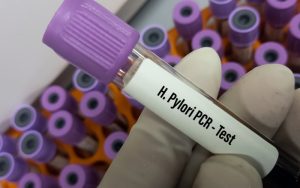
The focus of future research for Helicobacter Pilori Infection is on disease management, spreading awareness, and developing different technologies. The article focuses on the latest advancements in management, emerging treatments, and problems faced by healthcare professionals.
Contents
Overview
Helicobacter pylori is a gram-negative, spiral-shaped bacteria. It can tolerate the acidic environment of the stomach. It mainly attacks the digestive system including the stomach and duodenum (the first part of the small intestine).
The infection caused by H.pylori is a global health problem. It can lead to peptic ulcers and increase the risk of developing stomach cancer.
The symptoms of the disease include heartburn, nausea, vomiting, fatigue, weight loss, abdominal swelling, etc. The reason for the infection is the consumption of fecal-contaminated food – it can also spread through the saliva of patients.
Different diagnostic methods have been developed to increase specificity and sensitivity. There is an advancement in treatment therapies due to increased antibiotic resistance.
Emerging Treatment Strategies
Here are emerging treatment strategies against H.pylori infection.
1. Combination Therapies
The four therapy options are given below:
Triple therapy is the combination of a proton pump inhibitor with 2 antibiotics, usually clarithromycin and amoxicillin. Patients should take the recommended dose on time for 14 days.
Levofloxacin-based therapy is given in case a patient has resistance to clarithromycin. The combination of drugs is levofloxacin, amoxicillin, and proton pump inhibitors for 14 days.
Bismuth has bactericidal activity and is used in treatment. The therapy is based on the usage of bismuth, metronidazole, tetracycline, and proton pump inhibitors. The dose is recommended for 10-14 days.
Non- bismuth-based quadruple therapy includes proton pump inhibitors along with amoxicillin, clarithromycin, and nitroimidazole. Studies suggest that non-bismuth-based therapy is more effective in fighting off H.pylori infection.
2. Personalised Antibiotic Prescription
Antibiotic resistance can vary from individual to individual. Personalized antibiotic prescription is effective in combating resistance and offers effective treatment.
Susceptibility test is the most common test to find out which antibiotic will work best against infection. The practice is becoming common and has shown productive results in the treatment.
3. Endoscopic Mucosal Dissection
Endoscopic mucosal dissection is a minimally invasive technique to remove cancerous tissues from the gastrointestinal tract.
One of the main reasons for gastric cancer is H.pylori infection. The technique not only removes cancerous cells but also reduces the load of H.pylori from mucosal linings without surgery.
4. Nanoparticle Technology
Nanoparticle technology was recently introduced for the diagnosis and treatment of diseases. It has antimicrobial properties which makes it ideal against bacterial infections.
Nanoparticles are made of silver, copper, gold, zinc oxide, etc. These particles conjugated with antibiotics are a perfect combination against infections.

The mode of action of nanoparticles is as follows:
- Disrupt cell wall and cell membrane
- Inhibit the synthesis of DNA
- Generate reactive oxidation species (ROS)
- Release free metal ions which increase toxicity
5. Use Of Probiotics And Prebiotics
Probiotics are friendly microbes that are beneficial for your gut health. Some examples of probiotics are lactobacillus, bifidobacterium, yeast, etc. It helps in alleviating the severity of the condition.
Probiotics give competition to H.pylori by occupying space and nutrients – they also produce antimicrobial molecules.

Prebiotics are food for beneficial bacteria in the gut. These prebiotics aid in digestion, boost metabolism, and help fight off infections.
Advancements In The Management
The management of disease includes novel diagnostic methods, vaccination, antibiotic stewardship, and the use of artificial intelligence.
1. Novel Diagnostic Methods
There are broadly two diagnostic approaches: invasive and noninvasive methods.
Invasive Techniques For Diagnosis
Invasive techniques involve cutting or puncturing the skin to take samples for diagnosis. Some of the invasive diagnostic techniques are given below:
The rapid urea test is an easy, inexpensive, and easy test for the detection of H.pylori. This is a biochemical test that identifies the bacteria by a change in the color of the medium. The medium used for the test contains urea.

The bacterial growth in the medium releases urease enzymes that break down urea. The pH of the medium becomes alkaline which changes color from yellow to pink. The pink color after incubation hints towards the presence of H.pylori in the sample.
Diagnosis through culturing bacteria is a gold standard method for detection. It’s a traditional, time-consuming approach but confirms the presence of bacteria.
The main issue in the culturing of H.pylori is the contamination of other bacterial species. H.pylori is a microaerophilic bacteria therefore special conditions must be met to ensure its growth.

Modifications in Skirrow’s medium have shown increased sensitivity and specificity. Candle jars along with CampyGen sachets are used to ensure microaerophilic conditions.
Confocal laser endomicroscopy is the latest fluorescent microscopic technique to examine gastric mucosal histology. This laser technology is very beneficial in the diagnosis and treatment of gastrointestinal issues.

It uses high resolution and enables real-time examination of mucosa. It tells about the severity of disease, and early detection of gastric cancer and gives insight into the efficacy of treatment.
Non Invasive Technique
Non invasive diagnostic technique don’t involve cutting or puncturing of the skin.
Serological tests are rapid and accurate tests for the diagnosis of H.pylori. The principle of serological tests is the reaction between antigen and antibody.
Different serological tests include agglutination tests, ELISA tests, complement fixation tests, neutralization tests, etc.
The test is performed in the laboratory using a serum sample. Serological tests can be both qualitative or quantitative.
The urea breath test is commonly used in the diagnosis of H.pylori. It’s a relatively easy, simple, and rapid test.
Patients shouldn’t eat anything at least 4 hours before the test. The patient swallows a 100 mg capsule of 13C urea with water. After a few minutes of swallowing, the patient breathes into a glass tube.

The presence of H.pylori breaks down urea into ammonia and carbon dioxide. The detection of these compounds indicates the presence of H.pylori.
PCR (polymerase chain reaction) is a highly sensitive test in the world of diagnosis. The principle of the PCR technique is an amplification of the targeted gene sequence. It’s used as a confirmation test for H.pylori diagnosis.
The detection is possible using a very small amount of sample. Three basic steps in the amplification of DNA are denaturation of the template, annealing of primers, and extension of DNA strands.

The results of PCR are visualized through gel electrophoresis. It separates the DNA fragments according to their length. The ethidium bromide loaded in the electrophoresis tank gives luminous light on UV exposure.
2. Use Of Artificial Intelligence
AI intelligence can play a huge role in the management of H.pylori. The increasing risk of disease demands the use of modern technology to combat the challenge.
It can help in the following areas:
- Development of a large database
- Making of potential drugs for treatment
- Better analysis of endoscopic images
- Offer better treatment plans
- Advancement of nanotechnology
- Prediction of the number of upcoming cases
3. Vaccine Development
There is no vaccine against H.pylori. The main reasons are strain variations, the cost of vaccine development, ability to escape the immune system.

However, the research on vaccine development is active in many parts of the world. The main focus is on subunit, whole-cell, and live attenuated vaccines. Trials have shown some promising results but it needs more trials and research.
Vaccines significantly decrease the burden and help in disease management. It’s a prophylactic measure that develops immunity after encountering bacteria.
4. Antibiotic Stewardship
Misuse and overuse of antibiotics have increased resistance in H.pylori. Antibiotic stewardship is an effective strategy to fight off bacterial resistance.
The core elements of antibiotic stewardship are as follows:
- Higher level management to control overuse of antibiotics
- Training of physicians to recommend antibiotics when necessary
- Raise awareness on existing and upcoming antibiotic resistance
- Prescription of antibiotics after conducting susceptibility testing
- Find alternate ways to reduce the reliance on antibiotics
- Doctors should recommend narrow-spectrum antibiotics
Challenges Faced By Health Care Professional
Below are 4 main challenges that are faced by healthcare professionals.
1. Increasing Antibiotics Resistance
Antibiotic resistance is a major concern of health professionals. The main reason behind antibiotic resistance is misuse of antibiotics.

Multiple drug resistance in H.pylori is an alarming situation as it renders the antibiotic treatment ineffective. The mechanisms for antibiotic resistance include genetic mutations, changes in membrane permeability, efflux system, etc.
2. Difficulty In Vaccine Development
Vaccination can be an effective prophylactic measure to deal with H.pylori. Currently, there’s no vaccine available for the bacteria.
The challenges in vaccine development are as follows
- H.pylori can manipulate and escape the immune system
- The genetic changes and strain variations raise questions about vaccine efficacy
- The project of vaccine development is costly as it demands research and resources.
3. Lack Of Patient Adherence
Patient adherence refers to the patient’s behavior towards taking medication and following proper guidelines for the treatment.

The duration of treatment is mostly 2 weeks. Along with medication, dietary instructions such as avoiding spicy food, caffeine, and acidic food are recommended. Mostly, patients become careless about the directions which prolongs the treatment.
4. Insufficient Data
One major problem in the eradication of H.pylori infection is the lack of surveys. Many people are unaware of the risks associated with the infection.
A proper survey regarding the situation should be conducted. This data gives a broader picture and helps in taking preventive measures.
The information from physicians and lab technologists gives an insight into the effectiveness of tests and treatment procedures.






